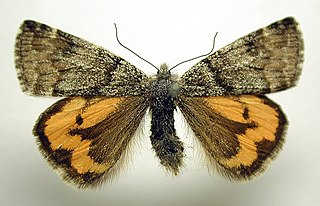Argyroeides is a genus of moths in the subfamily Arctiinae. The genus was erected by Arthur Gardiner Butler in 1876.

Archiearis notha, the light orange underwing, is a moth of the family Geometridae. The species was first described by Jacob Hübner in 1803 and can be found in Europe.
Argyroeides auranticincta is a moth of the subfamily Arctiinae. It was described by Edward A. Klages in 1906. It is found in Venezuela.
Argyroeides braco is a moth of the subfamily Arctiinae. It was described by Gottlieb August Wilhelm Herrich-Schäffer in 1855. It is found in São Paulo, Brazil.
Argyroeides eurypon is a moth of the subfamily Arctiinae. It was described by Herbert Druce in 1884. It is found in Guatemala.
Argyroeides flavicincta is a moth of the subfamily Arctiinae. It was described by Herbert Druce in 1905. It is found in Venezuela.
Argyroeides flavipes is a moth of the subfamily Arctiinae. It was described by George Hampson in 1898. It is found in Paraná, Brazil.
Argyroeides hadassa is a moth of the subfamily Arctiinae. It was described by Herbert Druce in 1883. It is found in Ecuador.
Argyroeides nephelophora is a moth of the subfamily Arctiinae. It was described by George Hampson in 1914. It is found in Paraguay.
Argyroeides ophion is a moth of the subfamily Arctiinae. It was described by Francis Walker in 1854. It is found in Venezuela and Santa Catarina, Brazil.
Argyroeides quindiensis is a moth of the subfamily Arctiinae. It was described by Paul Dognin in 1911. It is found in Colombia.
Argyroeides rubricauda is a moth of the subfamily Arctiinae. It was described by Harrison Gray Dyar Jr. in 1911. It is found in Colombia.
Argyroeides sanguinea is a moth of the subfamily Arctiinae. It was described by William Schaus in 1896. It is found in the Brazilian states of Paraná and Rio Grande do Sul.
Argyroeides spectrum is a moth of the subfamily Arctiinae. It was described by Schaus in 1911. It is found in Costa Rica.
Argyroeides strigula is a moth of the subfamily Arctiinae. It was described by Herbert Druce in 1896. It is found in São Paulo, Brazil.
Argyroeides tricolor is a moth of the subfamily Arctiinae. It was described by Packard in 1869. It is found in the Amazon basin.
Argyroeides vespina is a moth of the subfamily Arctiinae. It was described by William Schaus in 1901. It is found in Paraguay and Brazil.

The Euchromiina are a subtribe of tiger moths in the family Erebidae. It was described by Arthur Gardiner Butler in 1876. Many species in the subtribe are mimics of wasps. Euchromiina have always been considered closely related to the subtribe Ctenuchina due to their similarity to moths and wasps. These two subtribes make up around 3,000 valid species, the majority of which occur in the Neotropics.

Iris notha is a species in the genus Iris, it is also in the subgenus Limniris and series Spuriae. It is a rhizomatous perennial with deep blue or violet flowers from the Caucasus region. It is cultivated as an ornamental plant in temperate regions. It was once Iris spuria subsp. notha, and can often be found under that name. It has the common name of fake iris or mimic iris in Russia.
Ulmus × intermediaElowsky is a natural hybrid elm occurring across Nebraska and several other Midwestern states, derived from the crossing of Ulmus rubra and Ulmus pumila. As Red Elm U. rubra is far less fertile, and highly susceptible to Dutch elm disease (:DED), it could eventually be hybridized out of existence by U. × intermedia. The hybrid was first reported from the wild in the Chicago region in 1950 and was provisionally named U. × nothaWilhelm & Ware in 1994.


